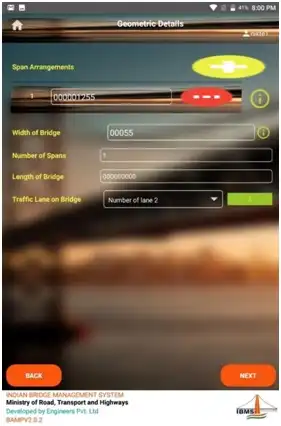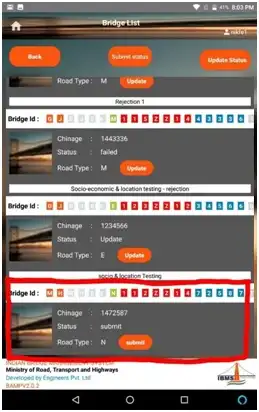This article highlights the principal reasons why the Indian Bridge Management System (IBMS) needed to be modified and how the Unified/ Universal Bridge Management System (UBMS) came into existence. On the National Highways of India, IBMS was implemented from 2015 to 2019. For every bridge, data was collected for a minimum of 4 data cycles. This implementation contributed valuable experience on what could be improved. During this implementation process, it was realized that certain modifications were essential in IBMS intending to make it more robust and functional to address the diverse needs of the client apart from BMS functionality. With that as a goal, our research team went back to the drawing board to add protocols that would make the system more efficient and universal. From this effort of the last 5 years, a Unified/Universal BMS was evolved which we call the UBMS.
Modifications in Database
IBMS had 5 basic data parameters under which the entire inventory details were accumulated.
- National Bridge Identity numbers
- Bridge Location number
- Bridge Classification number
- Bridge Structural Rating number
- Bridge Socio Economic Rating number
A need was felt to add administrative details related to the authority responsible for the bridge to increase the efficiency of response post a calamity so we have now added the Bridge Administrative details under inventory.

Certain data fields were required to bring more clarity; like additional information about direction of inspection was added under Location number. Similarly, information details of geometry of the bridge got clubbed under a new parameter called Bridge Geometry number with details of span arrangements, auto verification of length of bridge also got incorporated. The Structural Rating number was divided into two by creating a new Functional Rating number.
Codes Highlighted are those which existed in IBMS and those Highlighted are the new codes in UBMS.
So now under UBMS we have the following parameters in the inventory module
- Bridge Identity number (22A/N)
- State Code (2A)
- District Code (2A,2N)
- Type of road (1N)
- Highway no. (5A)
- Chainage (7N)
- Cumulative Bridge No. (3N)
- Bridge Location number. (30N, 30A)
- Latitude of bridge (9N)
- Longitude of bridge (9N)
- Direction of survey (30A)
- Date and time stamp (12N)
- Bridge Administrative details. ( A/N)
- Consultant’s name
- Popular name of bridge
- Custodian
- Engineer in charge
- Contact details (N)
- Email address
- Department chainage
- Department bridge number
- Bridge Geometry number. (68N)
- Span arrangement (50N)
- Total number of spans (3N)
- Width of bridge (5N)
- Length of bridge (9N)
- Traffic lanes on bridge (1N)
- Bridge Classification Number. (16A/N)
- Type of bridge (2A)
- Age of bridge (1N)
- Structural form (2N)
- Material of construction(1N)
- Loading as per IRC-6 (1N)
- HT arrangement (4A/N)
- Payload (4A/N)
- Bridge crossing feature (1N)
- Bridge Structural Rating number.
- Rating for Deck (1N)
- Rating for superstructure (1N)
- Rating for substructure (1N)
- Rating for Scour (1N)
- Bridge Functional Rating number.
- Rating for deck geometry (1N)
- Rating for Vertical clearance (1N)
- Rating for waterway adequacy (1N)
- Rating for Average daily traffic (1N)
- Bridge Socio-Economic Rating number
- Rating for Social importance (1N)
- Rating for Economic growth potential (1N)
- Rating for Alternate route (1N)
- Rating for environmental impact (1N)
Under UBMS we have digitized the entire inspection module so as to enhance the digital information about a particular bridge for a specific inspection cycle. This digitization has enabled UBMS to accept large number of inspection parameters for data mining. Any type of distress can be identified and the entire database of all bridges can be analysed for that type of distress. The consolidated inventory data and digitized inspection data, cater to better data mining and analysis functionality under UBMS.



Modifications in Protocol
The major findings of the 5 years of operating and managing IBMS were as under:
- IBMS protocol was a straight-line protocol where inventory would be followed by inspection and then if deemed essential by the client, the testing and repair/ rehabilitation modules could be activated. One could skip certain actions and yet continue with the process or move to the next cycle. This was done to avoid a situation where the process gets stuck due to required mandatory action. This ease of operation resulted in 4 cycles being completed without any distressed bridges being inspected, tested and remedial action required report being prepared. IBMS would allow the client could over-ride the testing and order the next cycle to start.
- The second finding of IBMS was resultant of lack of training of the inspection Engineers and inventory engineers. A system which is heavily dependent on correctness of inputs at every stage, requires certain standard procedure to assign codes and input values. Such standard procedure can only result from an institutionalized training process based on documented procedures. Else the system will need to be modified to ensure inputs are rechecked.
- IBMS did not have a testing protocol to identify with correct test being undertaken to be performed on the bridge for a particular type of distress. Such a loose end resulted in consultant or client deciding to enforce a testing protocol that was decided before the actual cause of distress was identified. Correct type of tests is required to bring in valuable inputs to the decision-making process of the system.
- Information and knowledge in the domain of principles of repairs to be adopted to address particular type of distress were defined in the last few years or at best a decade, much later than the actual development of IBMS system. The improvement in knowledge required the system to also adapt to this new knowledge base.
The resultant protocol under UBMS is now based on inventory Engineer completing the inventory with assignment of Rating numbers for Structural, Functional and Socioeconomic parameters. Under UBMS each rating number assigned at inventory is validated at inspection stage. During inspection stage post inspection these ratings are sought to be validated by the inspection Engineer who is a more experienced engineer than the inventory Engineer. The inspection Engineer then proceeds to prepare a prognosis for the cause of distress. The cause matrix assigned at inspection stage is confirmed by testing. This ensures that remedial action required report prepared is based on validated observations.

Based on the prognosis, the testing required to confirm the primary causes of distress is identified by the system and based on the results of the required testing the prognosis is either confirmed or rejected. Testing assigned is specific for the cause that is determined in the inspection stage so, testing done is specific for that cause and results in a validation process to confirm the prognosis. In case the test results in a negative result, it means the prognosis is wrong and hence rejected. Rejected prognosis requires a correct diagnosis to be redone and a different test regime to confirm the cause of distress. Importance of testing is a topic that will be dealt in the 3rd article of the series coming up in the next month.
Confirmed prognosis leads the system to identify the principle of remedial action required.
Both the testing and principle of remedial action are adopted from EN 1504 and current IRC SP 35 and 40 which are being modified. This modifications in protocol ensure the internal quality control and ensures flow of activities until the presentation of remedial action required report for distressed bridges.
UBMS has an internal validation of important inputs, which was essential as the ratings assigned to decide the course of management for the bridge.
Under UBMS it is mandatory to undertake testing for all distressed bridges, thereby confirmation of distress is ensured before remedial action can be initiated.
CONCLUSIONS
UBMS system has been evolved based on the experience of the team which worked on IBMS for 5 years and incorporates a new knowledge base that has evolved the world over in the past decade in the sphere of distress identification and definition.
UBMS system now available is updated to overcome the shortfalls of IBMS and is a better, updated and a quality efficient system. UBMS brings all innovations and knowledge updates related to BMS into the system.
The innovations in the sphere of science do not stop and to that level, the UBMS system developed now shall undergo further improvements every few years to keep the system updated and relevant to the age in which it is used. Research is an ongoing activity.
About the author:

The article is authored by SACHIDANAND JOSHI, Emeritus Chair—IBMS @ IDDC Engineers Pvt. Ltd.
All of the author’s career has been devoted to the Rehabilitation of structures. He has been a team leader to over 2000 inspection, repair and rehabilitation projects. Having seen the various causes of distress so closely and the extent of damage and loss that is caused by ZERO maintenance of various structures, he decided to devote his energy to conceptualize a system that can avoid this scenario. From that urge to minimize distress, came his focus on Asset Management Program.
SACHIDANAND JOSHI is presently working passionately to implement Asset Management Programs in various facades of the Civil Engineering industry in India. The author has ha flair to conceptualize projects and get the team to complete the micro-planning.

